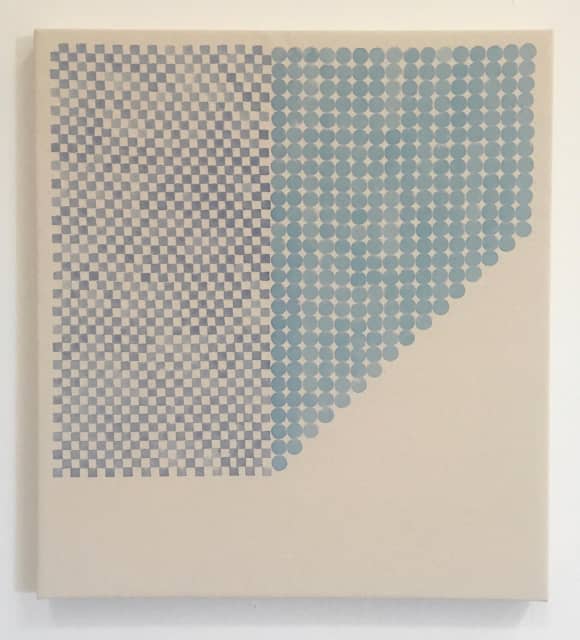

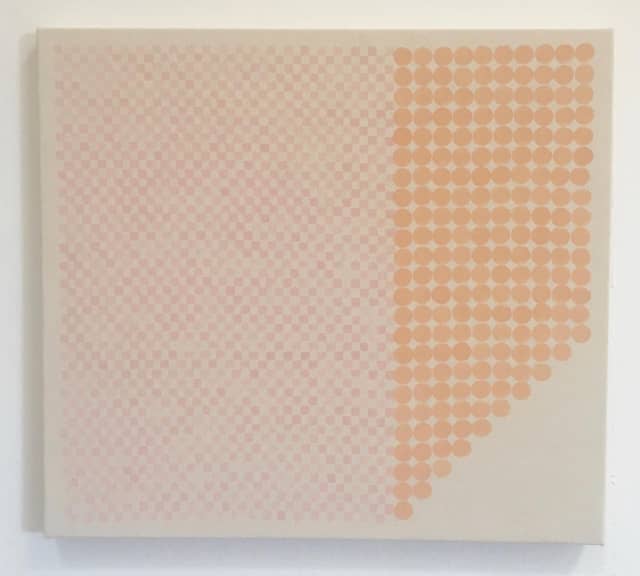

Corners and Curves - carrot stamping, acrylic and watercolor on canvas - by artist Jesper Dyrehauge. His primary working tool is carrot stamping - a way of re-negotiating prevalent conceptions of painting. Carrot stamping is a way of thinking through making; an embracing and reconfiguring of material and form, in which the outcome is partly conceived, but can never be fully known. This series was conceived on a residency in Los Angeles. “Sunlight became a critical mediator of my relationship with los angeles – a mediator which has the potential to produce new ways of thinking about color, form and the idea of the ‘fade'. LA is a contrasting study of color. the matte and polished colors of this city – deep and vibrant blues of the ocean and of the skies which reflect it, bright greens of overwatered lawns – sat in opposition to the bleached colors of the city's dyed relics – its cars, signs, buildings. when i entered people’s homes, i was often surprised to find the interiors dark, almost gloomy. rooms often had small windows with thick curtains, to keep out the hard bite of the sun. coming from denmark where sunlight is celebrated, i had never felt the need to curtain my windows. In LA the sun is not always a welcome stranger, but sometimes hostile. sun in los angeles is persistent, beating more aggressively than in northern europe. it bleaches all that it touches: old cars at the side of the road, resting in chipped and faded paint with custom made covers to protect their wrinkled dashboards from the sun; street signs and painted buildings fading in the force of the sun. these faded hues were not gaps in a chromatic vocabulary, but offered a whole new language of color. Fading is so often couched as a 'loss' of color: a dissolution of vibrancy, a bleaching of form. but, my experience in LA began to put this idea of the 'fade' into question. when color fades, it doesn’t disappear, but is transformed as a new color. colors are poetic, rather than grammatic – a faded color is not a color lost, but a color that has gained another texture. fading, i realised, can also be another path for growth." www.jesperdyrehauge.net
Reflections - a film by Peter Tukei Muhumuza, part of a series of films on light, energy, and life - see the entire series here: Little Sun
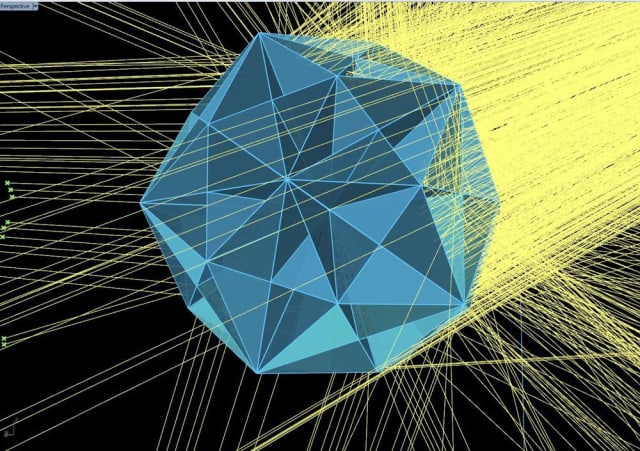
On-going research: Targeting rays on a spherical polyhedron built from kaleidoscopes. To influence light reflection, we have been looking into variations of mirror sphere-like shapes built from kaleidoscopes and mirrors. A challenge is finding the right structure based on geometrical symmetry that will then reflect light less randomly. We have been testing different structural designs by applying polyhedron geometry, but also investigating concave stellations of the Rhombic Triacontahedron. The use of parabolic concave mirrors helps to limit random reflection and by adjusting the orientation of specific mirrors, we can in a sense control the behavior of light.
Targeting rays, studio test
via Instagram
Studio Visits: Enrique Rivera Gallardo, researcher, curator and audiovisual producer. He is the president of the Chilean Video Corporation and Director of the Chile Media Arts Biennial, which promotes experimental video art in the region
www.soe.tv
Confetti - a film by Peru Ana Ana Peru - part of a series of films on light, life and solar energy - see more films here: Little Sun
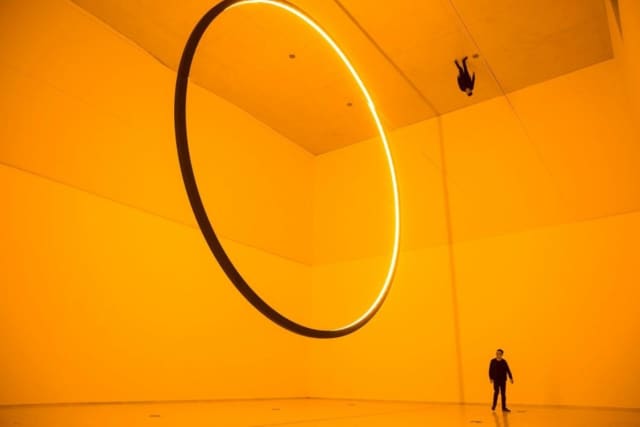
The unspeakable openness of things, Red Brick Art Museum, Beijing. Photo: Roman Pilipey
Fjordenhus, Denmark
via Instagram

If national identity or collective memory is seen as the result of a collection of representations, then it’s never too late to add to and improve on this narrative. I am Queen Mary - is a very good place to start this dialogue. The new, hopefully permanent statue is a monument of a rebel woman that challenges Denmark’s „forgotten“ colonial past (and the first public sculpture of a black woman in Denmark (!) Denmark’s past as a colonial power and slave nation is often overlooked in the narrative the country tells itself and others. Until 100 years ago the caribbean islands of St. Thomas, St. Croix og St. Jan were under danish rule. Mary Thomas was a leader of the ‘Fireburn’ labour revolt on St. Croix. The Fireburn began on October 1, 1878 as an uprising against the contractual servitude that continued to bind workers to the plantation system after the 1848 abolition of slavery in the former Danish West Indies. Created by the artists Danish artist Jeannette Ehlers and Virgin Islands artist La Vaughn Belle - they hope to challenge Denmark’s role in slavery, its colonial past and memorialize those who fought against it. The statue occupies the waterfront by Copenhagen’s West Indian Warehouse that stored sugar, rum and other goods produced in Denmark’s former Caribbean colonies. This temporary sculpture is the first part of an endeavour to raise a permanent bronze monument in the same location. Go visit in Copenhagen or on www.iamqueenmary.com
Yellow by Julio Hernández-Cordón - part of a series of films on light, life and solar energy - see more films here: Little Sun
The morning small cloud
Solecito by Oscar Ruiz Navia - part of a series of films on light, life and solar energy - see more films here: Little Sun

Studio roof top: A sun tracker is an instrument that redirects sunlight onto a fixed point by adjusting a mirror in concert with the ‘movement’ of the sun across the sky. In development at the studio for a number of years, the apparatus belongs to a family of optical devices called heliostats – a word deriving from Greek roots that mean stationary sun. In a sense to track the sun is to track yourself, because the sun tracker locates the centre of your orbital ellipse, giving your position right now and rendering visible your path. The reflexive potential lies in understanding that we are in a way the mirrors, circulating, tracking, spinning in our Keplerian ellipses. You and I are not the centre of the universe, but in fact spinning in altruistic space
Solar Syokoy - (this is not a film by Kwan) by Kwan - part of a series of films on light, life and solar energy - see more films here: Little Sun
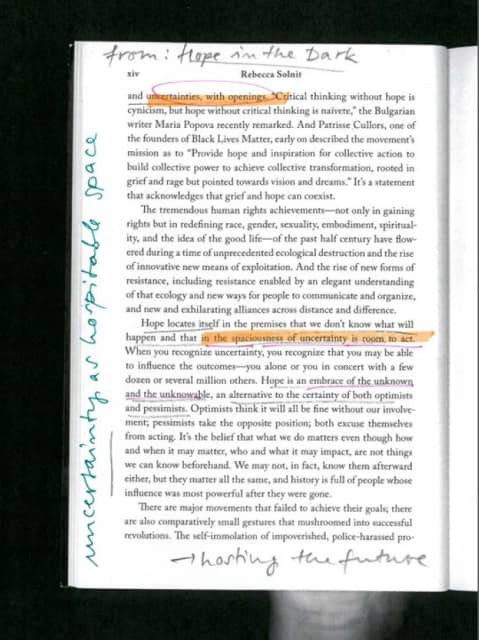
Excerpt from Hope in the Dark by Rebecca Solnit - in the new studio book, Open House
https://vimeo.com/1284717
Brilliant Noise by the artist duo Semiconductor takes us into the data vaults of solar astronomy. After sifting through hundreds of thousands of computer files, made accessible via open access archives, Semiconductor have brought together some of the sun's finest unseen moments. These images have been kept in their most raw form, revealing the energetic particles and solar wind as a rain of white noise. This grainy black and white quality is routinely cleaned up by NASA, hiding the processes and mechanics in action behind the capturing procedure. Most of the imagery has been collected as single snapshots containing additional information, by satellites orbiting the Earth. They are then reorganised into their spectral groups to create time-lapse sequences. The soundtrack highlights the hidden forces at play upon the solar surface, by directly translating areas of intensity within the image brightness into layers of audio manipulation and radio frequencies

https://www.youtube.com/watch?v=QgUzoo-r5_s&feature=youtu.be
Olafur speaking about energy access and Little Sun via Mashable

Firewood and battery-powered torches are the primary sources of light among the displaced community in Ethiopia, which prove to be challenging to collect or expensive to maintain. Internally displaced women and girls can be highly vulnerable to risks like gender based violence with displacement camps often located far from major infrastructure such as electricity.
Ader and her daughters say they always put it on when they head out to meet with neighbours after dark. “We have received water, food, and other essential items. Almost as important to us now is this light. It has become a real little sunshine in our house. We use it at night to cook and organize our place. Our house is much brighter. Now we spend hours talking around the light,” the mother said, explaining how the Little Sun has brought the family together around it. “Without this light it was dangerous to walk around outside at night.”
IOM - United Nations Migration Agency teamed up with Little Sun to bring an innovative, environmentally conscious alternative of solar lights to better equip displaced families to overcome such challenges. To date, over 20,000 Little Suns were distributed to internally displaced women in Ethiopia through IOM. The dignity kits accompanied 21,535 emergency shelter and core relief packages distributed by IOM in 2017.
Learn more about the Little Sun Foundation
Reality projector, Marciano Art Foundation, Los Angeles.
Sound recordings at the studio. This audio library was sent to the musician and sound artist Jónsi, who selected, mixed, and arranged the material in dialogue with Olafur into an ambient soundscape to accompany the artwork Reality projector
Greetings from Addis Ababa - from the Poetry Jazz: Wax and Gold.
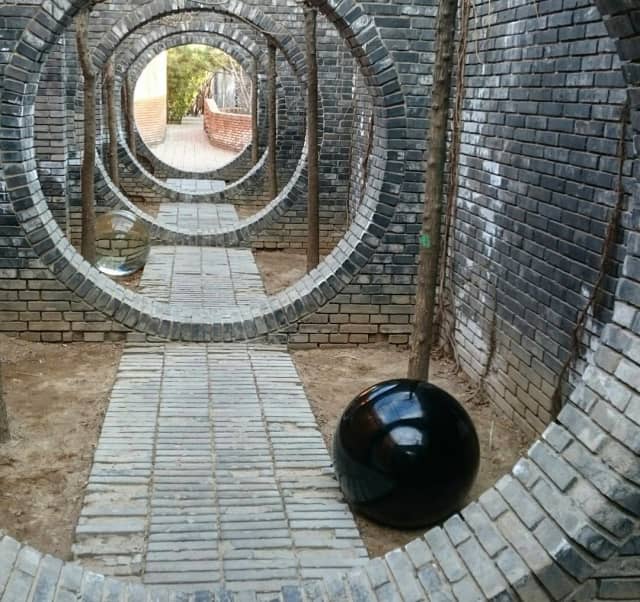
Two unthought thoughts at the Red Brick Art Museum, Beijing. The exhibition The unspeakable openness of things opens on Sunday